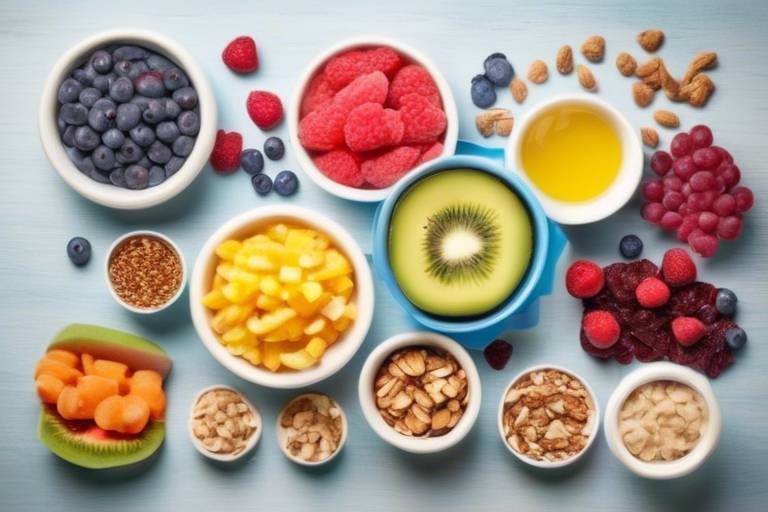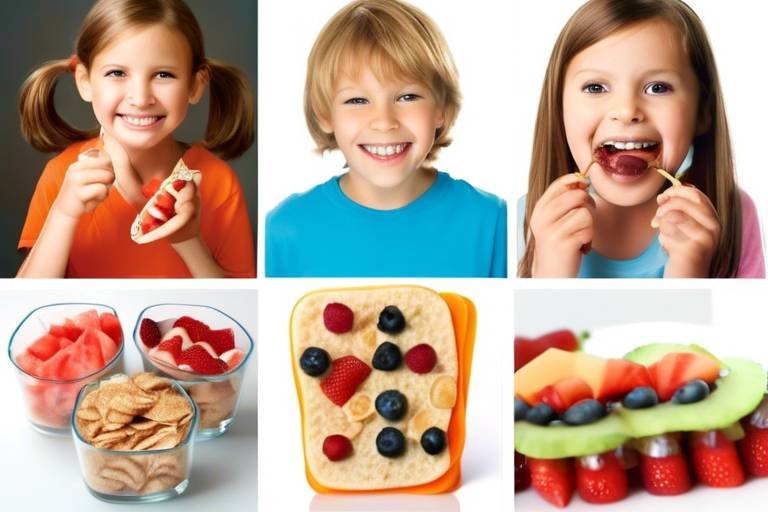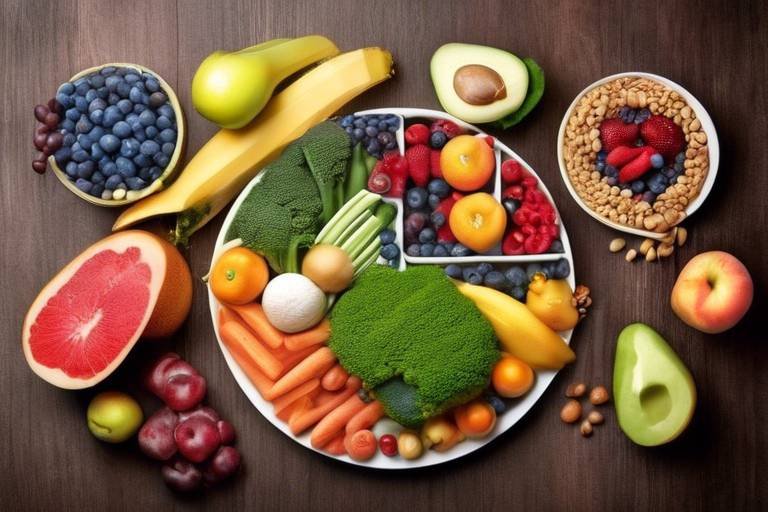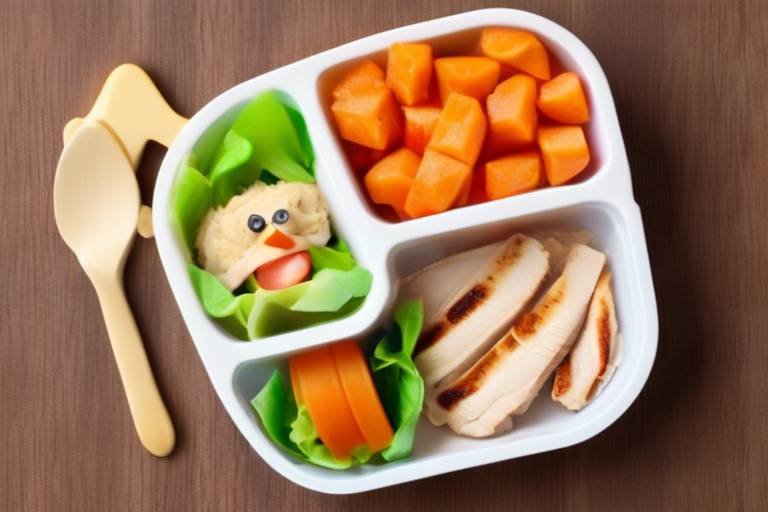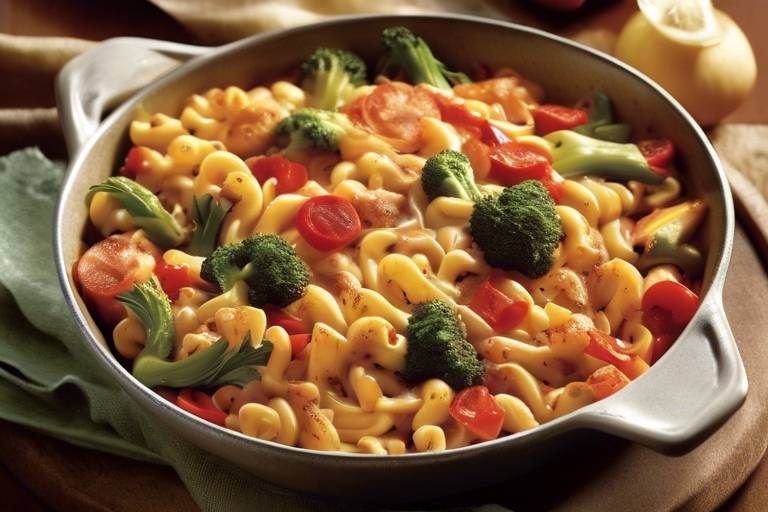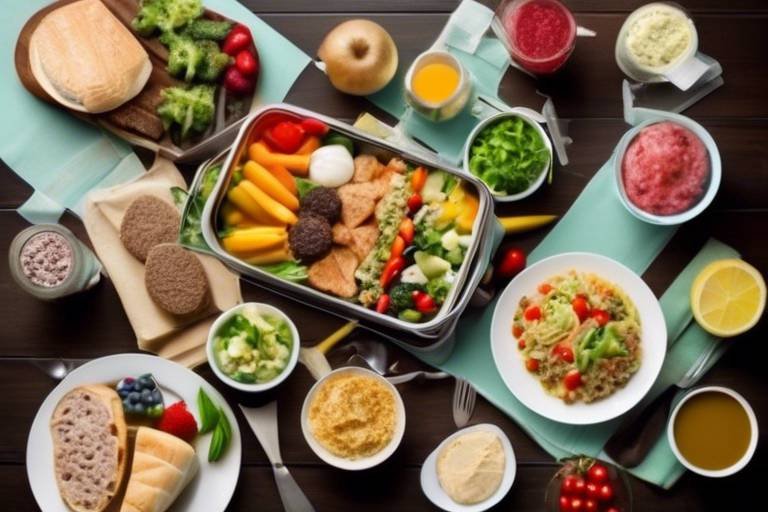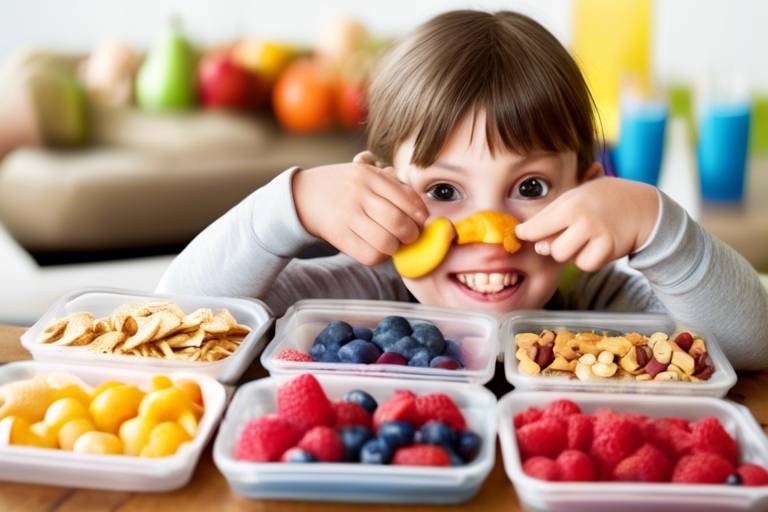10 Superfoods Your Kids Should Be Eating
Discover the essential superfoods that can enhance your children's nutrition, boost their energy, and support their growth. This article highlights ten nutrient-rich foods that every parent should consider incorporating into their kids' diets. In a world filled with fast food and sugary snacks, it’s crucial to provide our kids with the right fuel for their bodies and minds. Think of these superfoods as the superheroes of nutrition, ready to combat fatigue and promote healthy development. So, let’s dive into the colorful world of superfoods that can transform your child's diet!
Packed with iron and vitamins, spinach is a powerhouse leafy green that can enhance your child's health. Just imagine this vibrant green vegetable as a ticket to better energy levels and stronger immunity. Its versatility makes it easy to add to various dishes, from smoothies to pasta sauces, ensuring they receive essential nutrients without a fuss. Sneak in some spinach into a cheese omelet or blend it into a fruit smoothie, and watch as your kids embrace this nutrient-rich food without even knowing it!
These tiny fruits are loaded with antioxidants and vitamins. Blueberries can help improve memory and cognitive function, making them a fantastic snack for kids during study time or play. It’s like giving their brains a little boost of energy! Toss them into yogurt, sprinkle them on pancakes, or just serve them fresh for a sweet treat that packs a nutritional punch. Plus, their vibrant color is sure to attract your little ones' attention!
A complete protein source, quinoa is gluten-free and rich in fiber. It’s an excellent alternative to rice or pasta and can be easily incorporated into salads or main dishes for added nutrition. Think of quinoa as the little grain that could – it keeps your kids full longer and provides lasting energy for their adventures. Cook up a batch, mix in some veggies, and you have a delicious meal that’s as nutritious as it is satisfying!
Sweet potatoes are rich in beta-carotene and vitamins A and C. Their natural sweetness makes them appealing to kids, and they can be prepared in various delicious ways, from fries to mash. Imagine a world where your kids ask for more vegetables at dinner – that’s the power of sweet potatoes! Roast them, mash them, or turn them into a creamy soup; the options are endless, and the health benefits are undeniable.
High in protein and probiotics, Greek yogurt supports gut health and provides a creamy texture that kids love. It can be enjoyed plain or with fruits and honey for added flavor. Think of it as a blank canvas for healthy toppings! Mix in some granola, berries, or a drizzle of honey, and you’ve got a snack that’s not only tasty but also beneficial for digestion. It’s a win-win for both parents and kids!
Rich in omega-3 fatty acids, salmon is crucial for brain development. Incorporating this fish into your child's diet can promote healthy growth and improve concentration and learning abilities. Imagine your kids becoming little geniuses, all thanks to a delicious salmon dinner! Whether grilled, baked, or made into salmon cakes, this fish is a flavorful way to boost their brain power.
These nutrient-dense nuts are packed with healthy fats, fiber, and protein. Almonds make for a great snack or can be blended into smoothies, providing kids with energy and essential nutrients. Picture almonds as tiny powerhouses of nutrition – they keep your kids energized and satisfied between meals. Just a handful can make a significant difference in their daily intake of healthy fats and proteins.
Oats are a fantastic source of fiber and can keep children full longer. They can be served as oatmeal or added to smoothies and baked goods for a nutritious breakfast or snack. Think of oats as the reliable friend that always has your back when it comes to nutrition. They help regulate digestion and provide steady energy, making them an ideal choice for busy mornings.
Broccoli is loaded with vitamins, minerals, and fiber. This green vegetable can be served steamed, roasted, or raw, making it a versatile option that can enhance any meal while supporting your child's health. Imagine broccoli as the little tree that fights off illness and boosts immunity! It can be a fun addition to any plate, especially when paired with a tasty dip or cheese sauce.
Incorporating these superfoods into your child's diet not only enhances their nutrition but also sets the foundation for a lifetime of healthy eating habits. Think of each meal as an opportunity to fuel their bodies with the best possible ingredients. By introducing a variety of flavors and textures, you can help your kids develop a love for wholesome foods, making mealtime an enjoyable experience!
Q: How can I introduce these superfoods to my kids?
A: Start by incorporating small amounts into their favorite dishes. For example, add spinach to smoothies or mix blueberries into yogurt. Gradually increase their exposure to these foods in fun and creative ways!
Q: Are there any superfoods that should be avoided?
A: While most superfoods are beneficial, it's essential to consider allergies or intolerances. Always consult with a healthcare professional if you're unsure about introducing a new food into your child's diet.
Q: How can I make superfoods more appealing to picky eaters?
A: Get creative in the kitchen! Use colorful presentations, fun shapes, or involve your kids in the cooking process. Making meals interactive can help spark their interest in trying new foods.

1. Spinach
Discover the essential superfoods that can enhance your children's nutrition, boost their energy, and support their growth. This article highlights ten nutrient-rich foods that every parent should consider incorporating into their kids' diets.
Spinach is not just a leafy green; it's a nutrient powerhouse that can significantly benefit your child's health. Packed with iron, vitamins A, C, and K, spinach is an excellent addition to any meal. Did you know that iron is crucial for your child's energy levels and cognitive function? That's right! Including spinach in their diet can help keep them alert and active throughout the day.
One of the best things about spinach is its versatility. You can easily sneak it into a variety of dishes without them even noticing. Here are a few fun ideas to incorporate spinach into your kids' meals:
- Add it to smoothies for a nutrient boost.
- Mix it into pasta sauces for a vibrant color and extra vitamins.
- Use it as a base for salads, mixing in their favorite veggies and toppings.
- Try spinach pancakes or muffins for a delightful twist on breakfast.
Not only does spinach provide essential nutrients, but it also supports bone health due to its high vitamin K content. This vitamin is essential for calcium absorption, which is crucial for growing kids. Furthermore, spinach is rich in antioxidants, which help combat oxidative stress and keep your child's immune system strong. Think of spinach as a shield that protects your little ones from illnesses!
When it comes to preparing spinach, fresh or frozen varieties are both excellent options. If you choose fresh spinach, look for vibrant green leaves that are free from wilting or yellowing. If you're opting for frozen, make sure it's from a reputable brand that doesn't add any unnecessary preservatives. Cooking spinach lightly can enhance its flavor and make it easier for kids to enjoy. Try steaming or sautéing it with a little olive oil and garlic for a delicious side dish.
In summary, spinach is a superfood that every parent should consider adding to their child's diet. Its rich nutrient profile, versatility in meals, and health benefits make it an ideal choice for enhancing your child's nutrition. So, why not start today? Incorporate some spinach into your next meal and watch your kids thrive!
Q: Can I serve spinach raw to my kids?
A: Yes, absolutely! Raw spinach can be a great addition to salads or smoothies. Just make sure to wash it thoroughly.
Q: How can I get my picky eater to try spinach?
A: Try blending spinach into smoothies or incorporating it into their favorite dishes, like pasta or pizza. Making it fun and colorful can also entice them!
Q: Is it better to cook spinach or serve it raw?
A: Both raw and cooked spinach have their benefits. Cooking spinach can enhance its flavor and make certain nutrients more accessible, while raw spinach retains its vitamin C content. It's great to include both in your child's diet!

2. Blueberries
When it comes to superfoods, blueberries are like little blue powerhouses that can work wonders for your child's health! These tiny fruits are not only delicious but are also packed with a treasure trove of nutrients that can help enhance your child's well-being. Imagine a fruit that can boost memory, improve cognitive function, and provide a burst of energy—all in one bite! That's the magic of blueberries.
One of the most impressive aspects of blueberries is their high content of antioxidants, particularly anthocyanins, which give them their vibrant color. Antioxidants are essential for fighting off free radicals in the body, which can lead to various health issues. By incorporating blueberries into your child's diet, you're essentially giving their immune system a much-needed boost. Plus, they are an excellent source of vitamins C and K, which are crucial for maintaining a healthy body.
But how can you make sure your kids are getting enough of these delicious berries? The good news is that blueberries are incredibly versatile! Here are a few fun and easy ways to include them in your child's meals:
- Yogurt Parfaits: Layer blueberries with Greek yogurt and granola for a tasty breakfast or snack.
- Smoothies: Blend blueberries with bananas, spinach, and almond milk for a nutrient-packed smoothie.
- Pancakes: Add blueberries to pancake batter for a fruity twist on a breakfast favorite.
- Snacks: Serve fresh blueberries as a quick and healthy snack on their own or mixed with nuts.
Not only do these little berries taste great, but they can also make your kids feel great! Studies have shown that regular consumption of blueberries can improve memory and learning abilities, making them an ideal snack during study sessions or even before a big test. Think of them as brain food—like giving your child's brain a little boost of superpower!
In addition to their cognitive benefits, blueberries can also help support your child's heart health. Research suggests that the antioxidants in blueberries contribute to a healthier cardiovascular system, which is essential for growing children. It's like giving their hearts a gentle hug with every bite!
So, the next time you're at the grocery store, don't forget to grab a pint of blueberries. They are not just a treat; they are a nutritional powerhouse that can support your child's growth and development. With their sweet flavor and amazing health benefits, blueberries are a must-have in any kid-friendly diet!

3. Quinoa
Quinoa, often hailed as a superfood, is a grain-like seed that has gained immense popularity among health enthusiasts, and for good reason! This little powerhouse is not only gluten-free but also a complete protein source, which means it contains all nine essential amino acids that our bodies need. For kids, who are in their growing years, incorporating quinoa into their diet can be a game changer. Imagine giving your child a food that not only fills them up but also fuels their body with the nutrients it craves!
One of the best things about quinoa is its versatility. You can serve it in numerous ways, making it easy to sneak into your child's meals without them even noticing. Whether you mix it into a salad, use it as a base for a veggie bowl, or even bake it into muffins, quinoa can adapt to whatever culinary adventure you embark on. Plus, its nutty flavor and fluffy texture make it a delightful addition to any dish.
Here are some quick nutritional highlights of quinoa:
| Nutrient | Amount per 1 cup (cooked) |
|---|---|
| Calories | 222 |
| Protein | 8 grams |
| Fiber | 5 grams |
| Iron | 15% of Daily Value |
| Magnesium | 30% of Daily Value |
As you can see, quinoa is not just filling; it’s also packed with essential nutrients that can support your child's overall health. The fiber in quinoa can aid digestion, keeping their tummies happy and healthy. And let’s not forget about its role in maintaining energy levels. With a good dose of protein and fiber, quinoa can help keep your kids feeling fuller for longer, which means less snacking on sugary treats.
So, how can you introduce quinoa to your kids in a fun and exciting way? Here are a few ideas:
- Quinoa Salad: Mix cooked quinoa with colorful veggies and a light dressing for a refreshing meal.
- Quinoa Breakfast Bowl: Serve it warm with milk, honey, and fruits for a nutritious breakfast.
- Quinoa Burgers: Use quinoa as a base for homemade veggie burgers that are packed with flavor.
In conclusion, quinoa is a fantastic addition to your child's diet that not only enhances nutrition but also offers a variety of meal options. By integrating this superfood into their meals, you're not just feeding them; you're nourishing their bodies and supporting their growth in the most delicious way possible!

4. Sweet Potatoes
Sweet potatoes are not just a delicious treat; they are a nutritional powerhouse that can play a significant role in your child's diet. Rich in beta-carotene, which the body converts into vitamin A, sweet potatoes are essential for maintaining healthy vision, skin, and immune function. But that's not all! They are also packed with vitamins A and C, potassium, and fiber, making them a well-rounded food choice.
One of the best things about sweet potatoes is their natural sweetness, which makes them appealing to kids. Unlike regular potatoes, they have a unique flavor that can be enjoyed in various forms. Whether roasted, mashed, or made into fries, sweet potatoes can be transformed into exciting dishes that your children will love. For example, you can slice them into wedges, toss them with a little olive oil and seasoning, and bake them for a crispy snack that beats regular fries any day!
Moreover, sweet potatoes are incredibly versatile. Here are some fun and tasty ways to incorporate them into your child's meals:
- Sweet Potato Mash: Creamy and comforting, this dish can be a delightful side at dinner.
- Sweet Potato Pancakes: Combine mashed sweet potatoes with pancake batter for a nutritious breakfast twist.
- Sweet Potato Soup: A warm and soothing option that can be pureed for a smooth texture.
- Sweet Potato Smoothies: Blend cooked sweet potatoes with yogurt and fruits for a nutrient-rich drink.
But wait, there's more! Sweet potatoes are also a great source of complex carbohydrates, which provide sustained energy. This makes them an excellent option for children who are active and need a boost throughout their busy days. Not to mention, they have a low glycemic index, which means they can help maintain stable blood sugar levels. This is particularly important for kids, as it can help prevent those pesky sugar crashes that lead to crankiness and fatigue.
In summary, sweet potatoes are not just a tasty addition to your child's diet; they are a nutritional ally that can help support their growth and development. So, the next time you're planning meals, consider adding this vibrant vegetable to your shopping list. Your kids will thank you, and their bodies will too!
Q: How can I make sweet potatoes more appealing to my kids?
A: Try roasting them with a bit of cinnamon or making sweet potato fries. Dipping sauces can also make them more fun to eat!
Q: Are sweet potatoes healthier than regular potatoes?
A: Yes! Sweet potatoes have more vitamins and nutrients, particularly vitamin A, and they have a lower glycemic index.
Q: Can sweet potatoes be prepared in advance?
A: Absolutely! You can cook and mash or roast sweet potatoes ahead of time, then store them in the fridge for easy meal prep during the week.

5. Greek Yogurt
Greek yogurt is not just a trendy snack; it’s a nutritional powerhouse that can do wonders for your child's health. Packed with high-quality protein, this creamy delight is perfect for kids who need a boost of energy and nutrients throughout their busy days. But what makes Greek yogurt stand out from regular yogurt? For starters, it contains almost double the protein, which is essential for growing bodies. This means your child can stay fuller for longer, reducing the chances of unhealthy snacking.
One of the best things about Greek yogurt is its versatility. You can serve it in a variety of ways that cater to your child's taste preferences. Whether they love it plain, topped with fresh fruits, or drizzled with honey, Greek yogurt can easily become a staple in your household. Its creamy texture makes it a kid-friendly option that can also be incorporated into smoothies, baked goods, and even savory dishes. Think of it as a blank canvas that can take on different flavors, making healthy eating fun and exciting!
Moreover, Greek yogurt is a fantastic source of probiotics, which are beneficial bacteria that support gut health. A healthy gut can lead to improved digestion and even enhanced immunity, helping your child fend off those pesky colds and flus. Just imagine, a simple cup of Greek yogurt can be a shield against illness while also nurturing their growing bodies!
To help you understand the nutritional benefits of Greek yogurt better, here’s a quick comparison table:
| Nutrient | Greek Yogurt (1 cup) | Regular Yogurt (1 cup) |
|---|---|---|
| Calories | 100 | 150 |
| Protein | 20g | 10g |
| Fat | 0g (non-fat) | 8g |
| Calcium | 20% of Daily Value | 30% of Daily Value |
| Probiotics | Yes | Varies |
Incorporating Greek yogurt into your child's diet is simple. You can create a fun yogurt parfait by layering Greek yogurt with fruits and granola, or whip up a smoothie by blending it with bananas and spinach for a nutrient-rich treat. The possibilities are endless! So, why not make Greek yogurt a part of your family’s daily routine? It’s a delicious way to fuel your kids with the goodness they need to thrive.
Q1: Is Greek yogurt suitable for children with lactose intolerance?
A1: Many children with lactose intolerance can tolerate Greek yogurt better than regular yogurt due to its lower lactose content. However, it's best to consult with a pediatrician to determine what's right for your child.
Q2: How can I make Greek yogurt more appealing to my kids?
A2: You can enhance the flavor by adding natural sweeteners like honey or maple syrup, or mix in fruits, nuts, or even a sprinkle of cinnamon. Making yogurt parfaits or smoothies can also make it more exciting!
Q3: Can Greek yogurt be used in cooking?
A3: Absolutely! Greek yogurt can be used as a substitute for sour cream in recipes, added to sauces for creaminess, or even used in baking to add moisture to cakes and muffins.

6. Salmon
When it comes to nourishing your little ones, salmon stands out as a true superstar in the world of superfoods. This fish is not just a delicious option; it’s packed with omega-3 fatty acids, which are essential for brain development and overall health. Imagine your child's brain as a sponge, soaking up all the good stuff it can get—salmon is like the ultimate brain food, helping to enhance memory, concentration, and learning abilities.
But why exactly is salmon so beneficial? Let’s break it down:
- Omega-3 Fatty Acids: These healthy fats are crucial for cognitive function and can even help reduce the risk of developing certain mental health issues.
- High-Quality Protein: Salmon is a fantastic source of protein, which is important for growth, muscle development, and overall body function.
- Vitamins and Minerals: This fish is rich in vitamin D, which supports bone health, and B vitamins that boost energy levels.
Incorporating salmon into your child's diet can be as simple as serving it grilled, baked, or even in a tasty salmon patty. The natural flavors of the fish can be enhanced with a squeeze of lemon or a sprinkle of herbs, making it a dish that kids will actually want to eat. Plus, it can be paired with a variety of sides, from colorful veggies to whole grains, creating a balanced meal that’s both nutritious and appealing.
Here’s a quick and easy recipe to get you started:
Easy Baked Salmon 1. Preheat your oven to 400°F (200°C). 2. Place salmon fillets on a baking sheet lined with parchment paper. 3. Drizzle with olive oil, and season with salt, pepper, and your favorite herbs (like dill or parsley). 4. Bake for about 12-15 minutes, or until the salmon flakes easily with a fork. 5. Serve with a side of steamed broccoli and quinoa for a complete meal!
Not only does salmon taste great, but it also provides a wealth of health benefits that can support your child’s growth and development. So, why not make it a regular part of their diet? With its rich flavor and impressive nutrient profile, salmon is a delicious way to ensure your kids are getting the best nutrition possible.
Q: How often should my child eat salmon?
A: It’s recommended to include salmon in your child's diet at least 1-2 times a week to reap its health benefits.
Q: Can I serve salmon to kids who are picky eaters?
A: Absolutely! Try different preparations, such as salmon cakes or tacos, to make it more appealing.
Q: Is there a difference between wild-caught and farmed salmon?
A: Yes, wild-caught salmon typically has higher levels of omega-3s and fewer contaminants. However, both types can be part of a healthy diet.

7. Almonds
Almonds are not just a crunchy snack; they are a nutrient powerhouse that can significantly benefit your child's health. These small nuts are packed with healthy fats, fiber, and protein, making them an excellent addition to any diet. Imagine giving your child a snack that fuels their energy while also supporting their growth—sounds like a win-win, right?
One of the best things about almonds is their versatility. You can toss them into a bowl of yogurt, blend them into smoothies, or even use almond flour in baking. This means that whether your child is a picky eater or an adventurous foodie, there are plenty of ways to incorporate almonds into their meals. Did you know that just a handful of almonds can provide a significant amount of essential nutrients?
Here’s a quick look at what makes almonds so special:
| Nutrient | Benefits |
|---|---|
| Healthy Fats | Supports heart health and provides energy |
| Fiber | Aids in digestion and keeps kids feeling full |
| Protein | Essential for growth and muscle development |
| Vitamin E | Acts as an antioxidant, protecting cells from damage |
Almonds are also a fantastic source of vitamin E, a powerful antioxidant that helps protect your child's cells from damage. This is particularly important as kids are constantly on the go, playing, learning, and exploring. Including almonds in their diet can also help improve their concentration and memory, which is crucial for their academic success.
So, how can you make almonds a fun and tasty part of your child's routine? Here are a few ideas:
- Mix chopped almonds into their morning oatmeal or cereal for a crunchy twist.
- Blend almond butter into smoothies or spread it on whole-grain toast.
- Use them as a topping for yogurt, along with some fresh fruits for a delicious parfait.
Incorporating almonds into your child's diet not only enhances their nutrition but also teaches them to enjoy healthy snacks. It's like giving them a little nutritional superhero that fights off hunger and keeps them energized throughout the day. The best part? They’ll love the taste!

8. Oats
Oats are not just a breakfast staple; they are a nutritional powerhouse that can significantly benefit your child's health. Packed with fiber, oats are known for their ability to keep children feeling full longer, which can help curb unhealthy snacking throughout the day. Just imagine sending your little ones off to school with a breakfast that not only fuels their bodies but also fuels their minds!
One of the best things about oats is their versatility. You can prepare them in various ways to keep your kids excited about breakfast. Whether you opt for a warm bowl of oatmeal topped with fruits and nuts or a delicious smoothie that includes oats, the possibilities are endless. Moreover, oats can be easily incorporated into baked goods, making them a fantastic addition to muffins, cookies, or pancakes. Just think of a fluffy pancake that not only tastes great but also packs a nutritional punch!
Oats are especially beneficial for children's digestive health due to their high fiber content. They contain both soluble and insoluble fibers, which help regulate digestion and keep things moving smoothly in the gut. This is particularly important for growing kids, as a healthy digestive system can lead to better nutrient absorption and overall wellness. Plus, oats are low in calories, making them a smart choice for parents who want to promote healthy eating habits without sacrificing flavor.
When it comes to cooking oats, you can choose from various types, including:
- Instant Oats: Quick and convenient but often contain added sugars.
- Rolled Oats: A great balance of convenience and nutrition, they cook within minutes.
- Steel-Cut Oats: Less processed and higher in fiber, they take longer to cook but offer a chewy texture.
To make oats even more appealing, consider adding fun toppings! Here are some ideas:
- Fresh fruits like bananas, berries, or apples
- Nut butters for a creamy texture
- Honey or maple syrup for a touch of sweetness
- Chia seeds or flaxseeds for an extra health boost
Incorporating oats into your child's diet is a simple and effective way to enhance their nutritional intake. Not only do they provide essential vitamins and minerals, but they also promote sustained energy levels, making them ideal for active kids. So, why not start the day with a hearty bowl of oats? Your kids will love them, and you'll love how easy it is to keep them healthy!
Q: How can I make oats more appealing to my kids?
A: You can add fruits, nut butters, or honey to enhance the flavor. Experimenting with different toppings can make oats more exciting!
Q: Are oats gluten-free?
A: While oats themselves are gluten-free, they can be contaminated with gluten during processing. Look for certified gluten-free oats if your child has a gluten sensitivity.
Q: Can I use oats in baking?
A: Absolutely! Oats can be added to muffins, cookies, and pancakes to boost their nutritional value while adding texture.
Q: How do oats benefit my child's health?
A: Oats are high in fiber, which aids digestion, and they provide essential nutrients that help sustain energy levels and promote overall health.

9. Broccoli
Discover the essential superfoods that can enhance your children's nutrition, boost their energy, and support their growth. This article highlights ten nutrient-rich foods that every parent should consider incorporating into their kids' diets.
Packed with iron and vitamins, spinach is a powerhouse leafy green that can enhance your child's health. Its versatility makes it easy to add to various dishes, ensuring they receive essential nutrients.
These tiny fruits are loaded with antioxidants and vitamins. Blueberries can help improve memory and cognitive function, making them a fantastic snack for kids during study time or play.
A complete protein source, quinoa is gluten-free and rich in fiber. It's an excellent alternative to rice or pasta and can be easily incorporated into salads or main dishes for added nutrition.
Sweet potatoes are rich in beta-carotene and vitamins A and C. Their natural sweetness makes them appealing to kids, and they can be prepared in various delicious ways, from fries to mash.
High in protein and probiotics, Greek yogurt supports gut health and provides a creamy texture that kids love. It can be enjoyed plain or with fruits and honey for added flavor.
Rich in omega-3 fatty acids, salmon is crucial for brain development. Incorporating this fish into your child's diet can promote healthy growth and improve concentration and learning abilities.
These nutrient-dense nuts are packed with healthy fats, fiber, and protein. Almonds make for a great snack or can be blended into smoothies, providing kids with energy and essential nutrients.
Oats are a fantastic source of fiber and can keep children full longer. They can be served as oatmeal or added to smoothies and baked goods for a nutritious breakfast or snack.
Broccoli is not just a vegetable; it's a nutritional powerhouse that can play a significant role in your child's diet. Loaded with vitamins, minerals, and fiber, this green veggie is a must-have on your grocery list. Did you know that just one cup of cooked broccoli contains more vitamin C than an orange? It's true! This makes it an excellent choice for boosting your child's immune system.
One of the best things about broccoli is its versatility. You can serve it steamed, roasted, or even raw with a tasty dip. Kids often enjoy it more when it’s paired with something they love, such as cheese or a flavorful sauce. You can also sneak it into smoothies or blend it into pasta sauces for a nutritious boost without them even noticing!
Here’s a quick look at some of the key nutrients found in broccoli:
| Nutrient | Benefits |
|---|---|
| Vitamin C | Boosts immunity and skin health. |
| Vitamin K | Supports bone health and proper blood clotting. |
| Fiber | Aids digestion and keeps kids feeling full. |
| Folate | Essential for cell growth and metabolism. |
So, the next time you’re planning meals, remember that broccoli can easily enhance any dish. Whether it’s a side dish or a main course ingredient, it’s a fantastic way to ensure your kids are getting the nutrients they need to thrive.
Q: How can I get my kids to eat more broccoli?
A: Try incorporating it into their favorite meals or serve it with a dip. Making it fun and visually appealing can also help!
Q: Is frozen broccoli as nutritious as fresh?
A: Yes! Frozen broccoli retains most of its nutrients, making it a convenient option.
Q: Can I serve broccoli raw?
A: Absolutely! Raw broccoli can be a crunchy and nutritious snack. Just make sure to wash it thoroughly before serving.
Frequently Asked Questions
- What are superfoods and why are they important for kids?
Superfoods are nutrient-rich foods that offer significant health benefits. For kids, incorporating superfoods into their diet can enhance their growth, boost energy levels, and support overall health. Think of them as the superheroes of the food world, packing a punch of vitamins, minerals, and antioxidants that help kids thrive!
- How can I introduce spinach into my child's diet?
Spinach is incredibly versatile! You can sneak it into smoothies, mix it into pasta sauces, or even serve it raw in salads. Kids often love it when it’s blended with fruits in a smoothie, making it a fun and tasty way to get those greens in without them even noticing!
- Are blueberries really good for brain health?
Absolutely! Blueberries are loaded with antioxidants that help protect the brain from oxidative stress. They can enhance memory and cognitive function, making them a perfect snack for kids—especially before homework or study time. Plus, they taste great!
- Can quinoa be a good substitute for rice?
Definitely! Quinoa is not only gluten-free but also a complete protein, meaning it contains all nine essential amino acids. It’s a fantastic alternative to rice or pasta and can be used in salads, bowls, or even as a side dish. Your kids won’t even miss the rice!
- What’s the best way to prepare sweet potatoes for kids?
Sweet potatoes can be prepared in so many delicious ways! You can bake them, mash them, or even cut them into fries and bake them for a healthier option. Their natural sweetness usually appeals to kids, making them a hit at mealtime!
- How can I make Greek yogurt more appealing to my kids?
Greek yogurt can be a blank canvas for creativity! Try adding fresh fruits, a drizzle of honey, or even a sprinkle of granola. You can also blend it into smoothies for a creamy texture that kids will love. It’s a nutritious snack that can be both tasty and fun!
- Is it necessary for kids to eat fish like salmon?
While it’s not absolutely necessary, incorporating fish like salmon into your child's diet can provide essential omega-3 fatty acids crucial for brain development. If your kids aren’t fans of fish, try different cooking methods like grilling or baking with flavorful spices to make it more appealing!
- What are some easy ways to include almonds in my child's diet?
Almonds are a great snack on their own, but you can also blend them into smoothies, sprinkle them on yogurt, or use almond butter on toast. They’re packed with healthy fats and protein, making them a perfect energy booster for active kids!
- Are oats a good breakfast option for kids?
Yes! Oats are a fantastic breakfast choice because they’re high in fiber, which keeps kids feeling full longer. You can serve them as oatmeal topped with fruits or mix them into baked goods like muffins. They’re super versatile and can be enjoyed in many delicious ways!
- How can I get my kids to eat more broccoli?
Broccoli can be a tough sell, but you can make it more appealing by roasting it with a bit of olive oil and seasoning. You could also try blending it into a cheesy sauce or adding it to their favorite dishes. Making it fun and colorful can help pique their interest!

